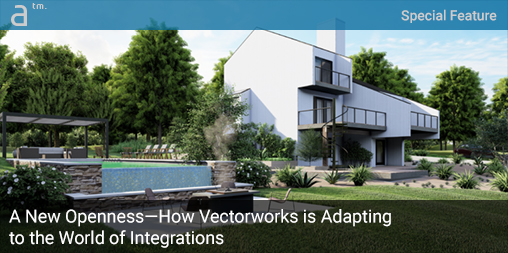VECTORWORKS USERS HAVE RARELY NEEDED MORE than what came inside the box. However, in the face of artificial intelligence (AI) and machine learning, bespoke computational design, augmented reality (AR), virtual reality (VR), and a host of other vanguard new technologies, things are changing at the Vectorworks mothership. The company—and its globally robust CAD/BIM platform—are developing unique core technologies that provide a new “openness” for Vectorworks and its stalwart users.
Vectorworks Graphics Sync (VGS)
This revelation may appear sudden, but the reality is it has been anticipated for some time. Years ago, when the company was developing its own OpenGL engine and new graphics pipeline, called Vectorworks Graphics Module (VGM), they were forced to think about how new low-level graphics APIs like Apple’s Metal and the Khronos Group’s Vulkan might impact the industry and their software. Now that core technology work in Vectorworks has positioned the company well with its new APIs for more openness—the system named Vectorworks Graphics Sync (VGS).
We have been investing for multiple years in the technologies powering our rendering engine, and being smart about that from the beginning has allowed us to bring additional openness to third-party rendering engines.
“The new connections to the third-party rendering engines is a result of us opening up our processes within Vectorworks,” says Steve Johnson, vice president of product development, Vectorworks, Inc. “We have been investing for multiple years in the technologies powering our rendering engine, and being smart about that from the beginning has allowed us to bring additional openness to third-party rendering engines.”
In March 2019, Vectorworks announced its partnership with Lumion and their leading LiveSync real-time rendering technology, and more broadly, this was the first partner plugin to use the Vectorworks Graphics Sync (VGS) application programming interface (API). “We provide third-party plugins starting points that have access to the newer API,” adds Johnson

A Lumion-powered rendering from Vectorworks thanks to the new Vectorworks Graphics Sync (VGS) API technology. More applications will now power live sync integrations thanks to this new openness philosophy and active third-party interests.
Fundamentally, basic objects and scene geometry are communicable to other applications and establish a persistent live connection, or live sync, so that work in one application is reflected in the other in real-time. Architosh saw this in action with Vectorworks and Lumion back at AIA 2019. This kind of connection to the Vectorworks BIM platform, in particular, can open up new types of workflows for users.
Beyond Rendering Engines—Total Project Lifecycles
While Architosh has already noted that the Vectorworks Graphics Sync APIs will also be bringing third-party renderers like Enscape and Twinmotion to Vectorworks in the near future, the system fundamentally communicates object data, including user-inputted data common in BIM applications. Additionally, Vectorworks users are also designing using GIS data—particularly landscape and urban design professionals. The new Esri ArcGIS Online services connectivity in Vectorworks is another advancement in the “openness” front for the application.
Johnson adds, “for us, the new openness is about being able to connect our customers to the whole project lifecycle through Vectorworks.” This means taking Vectorworks data into other applications and vice versa. I ask him about the Nemetschek Group sister products, and Johnson adds, “we are connecting more deeply to Solibri and Bluebeam, so we are connecting to the construction lifecycle. The Nemetschek Group brands definitely want to engage together more,” he adds.
The extension of Vectorworks into the complete design-build-operate lifecycle of buildings, performance spaces, landscapes, and infrastructure is a signal of Vectorworks customers deepening requirements. The AEC industry continues to advance through its 2D CAD to 3D BIM evolution; at the same time, new technologies and trends deepen the early stages of design—including pre-design—while building operators seek out the fruits of BIM data in operations.
Computational Design: Marionette and Rhino-Inside
Vectorworks Graphics Sync (VGS) is a C++ library API. However, while VGS is going to be the primary way professional software tools talk to Vectorworks and vice versa, it is not the only path for openness when it comes to coding and scripting new solutions and bespoke workflows. For several years now, Vectorworks has been using Python in lieu of its native VectorScript language. Python is the accessible and available language behind Vectorworks’ Marionette visual-scripting node-based computational design tool.
In the past few years, we have not heard much about Marionette in new annual releases, but notable Marionette-based projects are happening all the time with Vectorworks users. One very interesting one features the architecture firm Delacourt | Van Beek in Europe who used Marionette technology in a fascinating urban plaza installation that transposed the self-portrait of Vincent Van Gogh on to the plaza using four to five different shades of brick pavers. (see the film below.)
Still, while not showing all its cards now, the Nemetschek daughter company appears to be working on several possible avenues in the area of Marionette and computational design, including AI and machine learning specifically.
Dave Donley, director of product technology, Vectorworks, and who heads up its advanced research activities, says that the company is researching how to infuse Vectorworks with AI on multiple levels. “There is a spread of interesting applications [for AI] that we are pursuing,” he notes. Using AI for “image-processing and rendering are very close to my heart,” he adds, while noting that one way to dramatically speed up renderings is to do a coarse rendering and then use machine learning—a specific type of AI—to fill in the details very quickly.
We have multiple examples in-house showing machine learning running in Vectorworks using Python, for example.
The company is also continuously exploring tools like TensorFlow, an AI framework. “TensorFlow is a Python module, and Python is a native development environment for machine learning applications,” says Donley. “We have multiple examples in-house showing machine learning running in Vectorworks using Python, for example.” Donley discusses several more examples of some of the company’s research, but the more significant point is that Python is an accessible avenue for Vectorworks users to both engage with machine learning and AI but also to tie those AI frameworks into Marionette. “Marionette has a direct link to high-level objects in Vectorworks,” says Johnson, adding that the parameter controls in Marionette nodes can be exposed in the Vectorworks object’s control palettes.
The Vectorworks Graphics Sync technologies can also be used to talk to other data-driven computational tools—including Rhino-Grasshopper by McNeel and Associates. Acknowledging the popularity of Rhino+Grasshopper in architecture schools and marquee design firms, Johnson says they are more than aware of the new Rhino-Inside APIs from McNeel, adding: “Maybe with Rhino-Inside we find a way to connect them and make them work together; it’s not something that requires a very sophisticated office to take advantage of.”
Closing Thoughts
Vectorworks would prefer to advance their own integrated visual-scripting computational tools, just like Autodesk and Bentley, but in the spirit of this new “openness” philosophy beginning to drive development decisions at the company, it may be a smart move to connect Rhino+Grasshopper to Marionette to serve as a bridge and introduction to Marionette itself.
Earlier in the year, Architosh published a feature on the student work of Vectorworks Design Scholarship winners. Several of them, particularly in Europe, tend to see Vectorworks as this ultimate canvas for design, noting its graphics capabilities that make it perfect for competition entries and the production of beautiful drawings and presentation boards. The same was said during our profile story on the German landscape architecture firm scape Landschaftsarchitekten.
It has long been understood that Vectorworks stands apart in the industry when it comes to its ability to enable users to create beautiful drawings and visualizations. Now at this junction, in this new era of openness, perhaps the metaphor of the canvas can help guide how Vectorworks’ software development chooses to leverage integrations amongst the best third-party tools in the industry?
Integrations, after all, is how software users can extend their favorite products to tackle more aspects of design that come naturally when one thinks of the full lifecycle of design.




Reader Comments
[…] [02.28] Penna sul Trackpad del MacBook Pro [04.14] MacBook Air 2020 [10.39] eGPU [12.27] Apertura di Vectorworks verso altri standards [20.05] Animaionic Maximus e Mini [22.54] Francia verso edifici ecosostenibili [25.58] […]
Comments are closed.